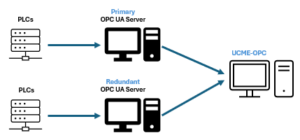UCME-OPC version 2024 is now released and available for download!
The main new features in this version are:
-
OPC-UA Server support

OPC UA (Open Platform Communications Unified Architecture) offers several benefits over OPC DA (OPC Data Access), particularly in terms of flexibility, security, and scalability. Here are some key advantages of OPC UA compared to OPC DA:
- Platform Independence: OPC UA is designed to be platform-independent, allowing it to run on various operating systems, including Windows, Linux, and macOS. In contrast, OPC DA is primarily tied to the Windows operating system.
- Security: OPC UA provides robust security features, including encryption, authentication, and authorization mechanisms, which are lacking or limited in OPC DA. OPC UA supports certificate-based authentication and encryption of data exchanged between clients and servers, ensuring secure communication over networks.
- Scalability: OPC UA offers enhanced scalability, allowing for more extensive and complex data models compared to OPC DA. OPC UA supports hierarchical data structures and complex data types, making it suitable for large-scale industrial applications with diverse data requirements.
- Information Modeling: OPC UA enables the creation of standardized information models, facilitating interoperability between different systems and vendors. OPC UA allows users to define custom data types, object models, and hierarchies, providing greater flexibility in representing industrial data.
- Built-in Redundancy: OPC UA includes built-in redundancy features, such as server failover and redundancy support, which enhance system reliability and availability. OPC UA servers can be configured to automatically switch to backup servers in case of primary server failure, minimizing downtime.
- Support for Modern Communication Protocols: OPC UA supports modern communication protocols, such as TCP/IP, HTTPS, and MQTT, enabling integration with a wide range of devices and systems, including cloud platforms and IoT devices. OPC UA’s support for web services facilitates seamless communication across different network infrastructures.
- Interoperability: OPC UA promotes interoperability between different industrial automation systems, allowing seamless integration and communication between devices, software applications, and platforms from different vendors. OPC UA’s standardized communication protocol ensures compatibility and consistency across diverse environments.
- Comprehensive Functionality: OPC UA offers a broader range of functionality compared to OPC DA, including support for alarms and events, historical data access, and complex data modeling capabilities. OPC UA’s extensible architecture allows for the addition of new features and functionality to meet evolving industry requirements.
Overall, OPC UA provides a more robust, secure, and flexible communication framework compared to OPC DA, making it well-suited for modern industrial automation and control systems.
-
OPC-UA Server redundancy
Using UCME-OPC version 2024 you can define two OPC UA redundant servers – Primary OPC UA Server and Secondary OPC UA Server. Assuming the two OPC servers’ real-time database is identical, UCME-OPC will automatically switch between the Primary OPC UA server and the Secondary OPC UA server. This eliminates the use of a 3rd party OPC Broker. This results lower costs and easier system maintenance.


